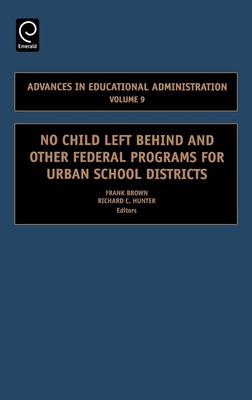
- We will send in 10–14 business days.
- Publisher: Jai Press Inc.
- ISBN-10: 0762312998
- ISBN-13: 9780762312993
- Format: 15.6 x 23.4 x 2.2 cm, hardcover
- Language: English
- SAVE -10% with code: EXTRA
No Child Left Behind and Other Federal Programs for Urban School Districts (e-book) (used book) | bookbook.eu
Reviews
Description
The No Child Left Behind (NCLB) Act is designed to close the achievement gap between disadvantaged and disadvantaged children through its Title I program. Title I provides disadvantaged students with compensatory education. Only Title I schools are required to meet NCLB accountability guidelines but some states apply federal accountability guidelines to non-Title I schools; and states must separate achievement test scores by racial subgroups. The book explores models to achieve equity in Title I schools. The authors define what is required of states in Title I schools. The NCLB guidelines are flexible: states may confine their accountability involvement to Title I schools only and limit the number of Title I schools in their state; states may establish their own standardized tests and establish their own racial subgroups. The authors examine how each state reacts and implements NCLB accountability standards, and challenges to these guidelines in the courts and in the body politics by states. The text examines the achievements of NCLB, and the implications of the Act. The text also reviews implications for a larger immigrant population that did not exist in 1965 when Title I was originally enacted by Congress; and the impact of globalization the educational needs of the country. It explores models to achieve equity under the No Child Left Behind (NCLB) Act.
EXTRA 10 % discount with code: EXTRA
The promotion ends in 19d.23:17:41
The discount code is valid when purchasing from 10 €. Discounts do not stack.
- Publisher: Jai Press Inc.
- ISBN-10: 0762312998
- ISBN-13: 9780762312993
- Format: 15.6 x 23.4 x 2.2 cm, hardcover
- Language: English English
The No Child Left Behind (NCLB) Act is designed to close the achievement gap between disadvantaged and disadvantaged children through its Title I program. Title I provides disadvantaged students with compensatory education. Only Title I schools are required to meet NCLB accountability guidelines but some states apply federal accountability guidelines to non-Title I schools; and states must separate achievement test scores by racial subgroups. The book explores models to achieve equity in Title I schools. The authors define what is required of states in Title I schools. The NCLB guidelines are flexible: states may confine their accountability involvement to Title I schools only and limit the number of Title I schools in their state; states may establish their own standardized tests and establish their own racial subgroups. The authors examine how each state reacts and implements NCLB accountability standards, and challenges to these guidelines in the courts and in the body politics by states. The text examines the achievements of NCLB, and the implications of the Act. The text also reviews implications for a larger immigrant population that did not exist in 1965 when Title I was originally enacted by Congress; and the impact of globalization the educational needs of the country. It explores models to achieve equity under the No Child Left Behind (NCLB) Act.


Reviews